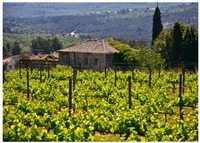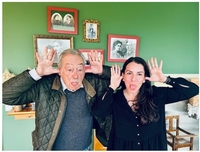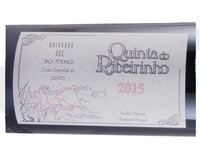|
|
 |

Portugal’s Bairrada and Dão may not be as widely known in the United States as some of their counterparts like Porto and the Douro Valley. However, these wine regions are quietly becoming the best destinations in Europe for wine travel. Both areas are gradually establishing themselves as some of the most interesting in Portugal due to their distinctive soil compositions and climate characteristics that combine to make wines with real distinction.
During a recent visit, I explored offerings from exciting, idiosyncratic winemakers making exceptional wines. I experienced firsthand the remarkable wines these regions produce, from crisp whites to rich reds and everything in between. Traveling through these regions is an absolute delight, with many narrow roads twisting through the fertile vineyards that link dozens of attractive little towns and villages. But the true strength of Bairrada and Dão is their great wines — and wine values — that cement their status as world-class destinations.
The Dão Region
 The Dao wine region, situated in the central northern part of Portugal, has been quietly honing its craft for centuries. The Dão wine region is the second oldest demarcated wine region in Portugal, officially established in 1908 and now recognized as a modern Denominação de Origem (DO). Nestled amidst hills and valleys, the region finds itself embraced by significant mountain ranges on three sides — north, west, and east. Vineyards dotting the landscape sprawl across altitudes ranging from 1200 to 1600 feet, with recent plantings reaching elevations as high as 2500 feet above sea level.
Its mountainous topography ensures a wide variety of microclimates, most of which have significant diurnal temperature ranges, even in the heat of summer. The soils here are mainly granite, ranging from underground granitic rock to well-drained granitic sand. The combination of topography, climate, and soils allows the region to produce fresh, bright wines with structure and body of many varieties, often with more elegance and finesse than the country’s warmest (and more famous) wine regions. The vineyards are made up of a wide variety of grape varieties. Touriga Nacional is the region's most frequently planted red grape, along with Alfrocheiro, Tinta Roriz (also known as Tempranillo), and Jaen (also known as Mencía). The most common white varieties include Encruzado, Malvasia Fina, Bical, and Cerceal Branco (not to be confused with the Sercial variety from Madeira).
From these varieties and many others, the producers in the region make sparkling wines, rosés, crisp whites, lightly colored reds, and richer, meatier reds. However, reds have long made up the majority of the region’s production. It is said that Dão wines can have outstanding aging potential. With their strong tannic backbone and healthy doses of acidity, the region’s reds make some excellent candidates for cellaring. Similarly, the acidity profile that characterizes many of the whites can make very age-worthy wines.
More than 150 small producers are making wine in the region, along with several remaining cooperatives. Dão is working to show its unique qualities, its maverick winemakers holding on to traditional styles, resisting the blockbuster reds growing in other regions, and still making terroir-driven wines capable of aging for decades.
The Bairrada Region
Meanwhile, in the Bairrada region, a similar story of excellence in winemaking is unfolding. The Denomination of Controlled Origin (DOC Bairrada) for red and white wines dates from 1979 and sparkling wines from 1991. Located in the northwest of Portugal, Bairrada is characterized by its maritime climate, relatively flat layout (vineyards rarely exceed 400 feet in altitude), and clay and limestone soils that give Barriada wines characteristic freshness and complex aromas. The moderate summers and mild winters, coupled with the Atlantic Ocean influence, create a microclimate that allows for a slow maturation of its grapes, showing great balance and natural acidity.
Bairrada proudly stands as one of Portugal's premier regions for producing sparkling wines, crafted meticulously using the traditional champagne method, with a secondary fermentation in the bottle. However, what truly sets Bairrada apart is its steadfast devotion to an indigenous grape variety: Baga. While largely overlooked elsewhere, Baga thrives in Bairrada, yielding exceptional red and sparkling wines. Traditionally, Baga wines are characterized by rough-and-tumble tannins and pronounced acidity, often exhibiting a raw intensity in their youth and resisting mellowing with age. Yet, Luis Pato, renowned as one of Bairrada's foremost producers and a staunch advocate for the Baga grape, has proven that Baga merits far more recognition than it has historically received.
 Luis Pato considers himself a nonconformist and has been known to rebel against the wine establishment. In that spirit, he has been championing the indigenous varieties in Barraida for decades. His two daughters, Filipa and Maria, are doing the same with their wine projects. Regarding Baga, Luis produces red Baga wines that share characteristics with Nebbiolo and approach the elegance of Pinot Noir in riper vintages. However, Pato noted, “From Baga, I can make a very elegant, sharp, and delicate sparkling wine, a fresh and juicy young red, and a boldly structured wine that can age endlessly.’ Pato also crafts gorgeous wines from Bical, Cerceal, and Maria Gomes grapes, among others.
Aside from Pato, there have been some real modernizers in Bairrada. While many have focused on Baga for reds, others have turned to other Portuguese red varieties like Touriga Nacional, also important in the region. Its floral aromas and structured tannins complement Baga and a host of international varieties. Bairrada DOC allows for Cabernet Sauvignon, Merlot, Syrah, and others. For decades, Bairrada was known mainly for its red and sparkling wines, but in recent decades, the production of white wines has also gained prominence in the region. Native grape varieties, such as Bical and Maria Gomes, are often used to produce fresh and aromatic white wines, with Bicals often used to give freshness and body to the more aromatic Maria Gomes.
Barriada is notably a region that bridges modern and traditional. It has coped well with an influx of international varieties and imports from elsewhere in Portugal. These combined elements give Bairrada wines a unique identity. Bairrada has adeptly blended these influences to craft wines with a distinct and unparalleled identity.
Gastronomic Specialties of the Regions
Both regions are renowned for crafting gastronomic wines. Accordingly, these regions have a strong gastronomic tradition related to their wines, which is one of the keys to Bairrada and Dão's success. José Lourenço of Quinta dos Roques, a family-owned winery in the heart of Dão, shared that both “Dão and Bairrada are regions with strong gastronomic traditions, and the winemaking in both regions has evolved around that. There is no better way to understand the style of Dão and Bairrada wines than having them at the table with the traditional dishes the regions are known for.”
An essential aspect of the tasting journey is pairing the region's wines with local cuisine. No visit to Bairrada is fulfilled without savoring a Bairrada sparkling wine alongside Leitão (roast suckling pig), an iconic dish. In Dão, José suggests complementing reds with tender meats like Cabrito (lamb) or game meats such as wild boar, while Encruzado pairs exquisitely with traditional Serra da Estrela cheese or codfish dishes.
Where and What to Sip
Here are a few picks from the vineyards I visited and now have stashed in my cellar that illustrate what these fascinating wine regions can produce.
João Pato Maria Duck Pét-Nat, Barraida, Portugal ($22): The Pato family is responsible for putting Portugal’s Barraida region on the international wine stage. This hazy, tart and wild pét-nat is made by Maria under the João Pato or Duckman pseudonym. At only 10.2% alcohol, this is the sort of wine that can take you through the whole afternoon. 91 Points
 2015 Luis Pato, Quinta de Ribeirinho Pé Franco, Barraida, Portugal ($160): 2015 Luis Pato, Quinta de Ribeirinho Pé Franco, Barraida, Portugal ($160): This was aged 24 months in new French oak and comes in at just 12.5% alcohol. This is sourced from ungrafted Baga vines that Luis planted in one of his vineyards, which is his top wine. This is concentrated and dense but shows elegance and poise with well-integrated oak and good structure. A bevy of black cherries, currants, bitter chocolate, cinnamon, espresso, orange peel, tar, dried rose, and meaty earth will envelop your palate. This is a serious effort with impeccable balance that should age magnificently. 98 Points
2020 Quinta das Bágeiras Tinto Reserva, Barraida, Portugal ($19): A blend of 60% Baga and 40% Touriga Nacional that opens quickly with a broad range of aromatics of dark berry and stone fruit kissed with baking spice. The rich palate offers flavors of spiced blackberries, currants, and plums, balanced by soft acidity and firm tannins. The finish is long, dry, and complex. 92 Points
2020 Caminhos Cruzados “Reserva” Encruzado, Dão, Portugal ($35): Pale gold in the glass, this wine delivers aromatics of wet stone and citrus, with similar flavors and a firm mineral line that supports hints of orange peel, stone fruit, plus a touch of tannic grip. It is beautifully textured, with lively acidity, freshness, and a long and persistent finish. It is a very gastronomic wine with phenomenal aging potential. 91 Points
2011 Julia Kemper Wines Reserva, Dão, Portugal ($24): The 2011 Reserva red is a blend of 50%, Touriga Nacional, 25%, Tinta Roriz, 15%, Alfrocheiro and 10% Jaen. This is an incredible bargain, given the depth and complexity. Aromas of dried strawberries, currant, and forest floor take hold. The palate is incredibly structured, with grippy yet smoothed tannins and a beautiful lift of freshness on the finish. It’s driven by earth and minerality, with red and black fruits peeking through spice components. 94 Points
2019 Quinta dos Roques Touriga Nacional, Dão, Portugal ($30): This well-made red opens with aromas of fresh violets, pine and red fruit. It has fine depth, good freshness, beautiful structure with firm tannins and a long finish. This is a super Touriga Nacional that should develop and improve nicely. 93 Points
|
 |
|